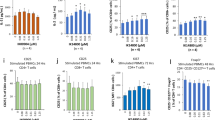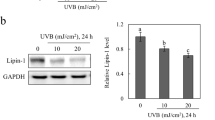Abstract
Induction of apoptosis of keratinocytes by ultraviolet (UV) radiation is a protective phenomenon relevant in limiting the survival of cells with irreparable DNA damage. Changes in UV-induced apoptosis may therefore have significant impact on photocarcinogenesis. We have found that the immunomodulatory cytokine IL-12 suppresses UV-mediated apoptosis of keratinocytes both in vitro and in vivo. IL-12 caused a remarkable reduction in UV-specific DNA lesions which was due to induction of DNA repair. In accordance with this, IL-12 induced the expression of particular components of the nucleotide-excision repair complex. Our results show that cytokines can protect cells from apoptosis induced by DNA-damaging UV radiation by inducing DNA repair, and that nucleotide-excision repair can be manipulated by cytokines.
This is a preview of subscription content, access via your institution
Access options
Subscribe to this journal
Receive 12 print issues and online access
$209.00 per year
only $17.42 per issue
Buy this article
- Purchase on Springer Link
- Instant access to full article PDF
Prices may be subject to local taxes which are calculated during checkout








Similar content being viewed by others
References
Murphy, G., Young, A. R., Wulf, H. C., Kulms, D. & Schwarz T. The molecular determinants of sunburn cell formation. Exp. Dermatol. 10, 155–160 (2001).
Ziegler, A. et al. Sunburn and p53 in the onset of skin cancer. Nature 372, 773–776 (1994).
Kulms, D. et al. Nuclear and cell membrane effects contribute independently to the induction of apoptosis in human cells exposed to UVB radiation. Proc. Natl Acad. Sci. USA 96, 7974–7979 (1999).
Stege, H. et al. Enzyme plus light therapy to repair DNA damage in ultraviolet-B-irradiated human skin. Proc. Natl Acad. Sci. USA 97, 1790–1795 (2000).
Aragane, Y. et al. Ultraviolet light induces apoptosis via direct activation of CD95 (Fas/APO-1) independently of its ligand CD95L. J. Cell. Biol. 140, 171–182 (1998).
Rehemtulla, A., Hamilton, C. A., Chinnaiyan, A. M. & Dixit, V. M. Ultraviolet radiation-induced apoptosis is mediated by activation of CD-95 (Fas/APO-1). J. Biol. Chem. 272, 25783–25786 (1997).
Sheikh, M. S., Antinore, M. J., Huang, Y. & Fornace, A. J. Jr. Ultraviolet-irradiation-induced apoptosis is mediated via ligand independent activation of tumour necrosis factor receptor 1. Oncogene 17, 2555–2563 (1998).
Schwarz, A. et al. UVB induced apoptosis of keratinocytes. Evidence for partial involvement of tumour necrosis factor α in the formation of sunburn cells. J. Invest. Dermatol. 104, 922–927 (1995).
Hill, L. L. et al. Fas ligand: a sensor for DNA damage critical in skin cancer etiology. Science 285, 898–900 (1999).
Leverkus, M., Yaar, M. & Gilchrest, B. A. Fas/Fas ligand interaction contributes to UV-induced apoptosis in human keratinocytes. Exp. Cell. Res. 232, 255–262 (1997).
Gloster, H. M. & Brodland, D. G. The epidemiology of skin cancer. Dermatol. Surg. 22, 217–226 (1996).
Kothny-Wilkes et al. Interleukin-1 protects transformed keratinocytes from TRAIL-induced apoptosis. J. Biol. Chem. 273, 29247–29253 (1998).
Kothny-Wilkes, G., Kulms, D., Luger, T. A., Kubin, M. & Schwarz, T. Interleukin-1 protects transformed keratinocytes from tumour necrosis factor-related apoptosis-inducing ligand- and CD95-induced apoptosis but not from ultraviolet radiation-induced apoptosis. J. Biol. Chem. 274, 28916–28921 (1999).
Luger, T. A. & Schwarz, T. Effects of UV-light on cytokines and neuroendocrine hormones. In Photoimmunology (eds Elmets, C. & Krutmann, J.) 55–76 (1995).
Patrick, M. H. Studies on thymine-derived UV photoproducts in DNA I. Formation and biological role of pyrimidine adducts in DNA. Photochem. Photobiol. 25, 357–372 (1977).
Aragane, Y. et al. IL-12 is expressed and released by human keratinocytes and epidermoid carcinoma cell lines. J. Immunol. 153, 5366–5372 (1994).
Koch, F. et al. High level IL-12 production by murine dendritic cells: upregulation via MHC class II and CD40 molecules and downregulation by IL-4 and IL-10. J. Exp. Med. 184, 741–746 (1996).
Magram, J. et al. IL-12-deficient mice are defective in IFN gamma production and type 1 cytokine responses. Immunity 4, 471–481 (1996).
de Laat, W. L., Jaspers, N. G. & Hoeijmakers, J. H. Molecular mechanism of nucleotide excision repair. Genes Dev. 13, 768–785 (1999).
Rünger, T. M., Möller, K., Jung, T. & Dekant, B. DNA damage formation, DNA repair, and survival after exposure of DNA repair-proficient and nucleotide excision repair-deficient human lymphoblasts to UVA1 and UVB. Int. J. Radiat. Biol. 76, 789–797 (2000).
Fairbairn, D. W., Olive, P. L. & O' Neill, K. L. The comet assay: a comprehensive review. Mutat. Res. 339; 37–59 (1995).
Arlett, C. F. et al. Hypersensitivity of human lymphocytes to UV-B and solar irradiation. Cancer Res. 53, 609–614 (1993).
Green, M. H. et al. UV-C sensitivity of unstimulated and stimulated human lymphocytes from normal and xeroderma pigmentosum donors in the comet assay: a potential diagnostic technique. Mutat. Res. 273, 137–144 (1992).
de Vries, A. et al. Increased susceptibility to ultraviolet-B and carcinogens of mice lacking the DNA excision repair gene XPA. Nature 377, 169–173 (1995).
van Oosten, M. et al. Differential role of transcription-coupled repair in UVB-induced G2 arrest and apoptosis in mouse epidermis. Proc. Natl Acad. Sci. USA 97, 11268–11273 (2000).
Kraemer, K. H., Lee, M. M., Andrews, A. D. & Lambert, W. C. The role of sunlight and DNA repair in melanoma and nonmelanoma skin cancer. The xeroderma pigmentosum paradigm. Arch. Dermatol. 130, 1018–1021 (1994).
Simon, M. M. et al. Heat shock protein 70 overexpression affects the response to ultraviolet light in murine fibroblasts. J. Clin. Invest. 95, 926–933 (1995).
Duckett, C. S. et al. Human IAP-like protein regulates programmed cell death downstream of bcl-xL and cytochrome c. Mol. Cell. Biol. 18, 608–615 (1998)
Wright, S. C., Wang, H., Wei, Q. S., Kinder, D. H. & Larrick, J. W. Bcl-2-mediated resistance to apoptosis is associated with glutathione-induced inhibition of AP24 activation of nuclear DNA fragmentation. Cancer Res. 58, 5570–5576 (1998).
O'Donovan, A., Davies, A. A., Moggs, J. G., West, S. C. & Wood, R. D. XPG endonuclease makes the 3' incision in human DNA nucleotide excision repair. Nature. 371, 432–435 (1994).
Mu, D., Hsu, D. S. & Sancar, A. Reaction mechanism of human DNA repair excision nuclease. J. Biol. Chem. 271, 8285–8294 (1996).
de Laat, W. L., Jaspers, N. G. & Hoeijmakers, J. H. DNA-binding polarity of human replication protein A positions nucleases in nucleotide excision repair. Genes Dev. 13, 768–785 (1999).
Kenny, M. K., Schlegel, U., Furneaux, H. & Hurwitz, J. The role of human single-stranded DNA binding protein and its individual subunits in simian virus 40 DNA replication. J. Biol. Chem. 265, 7693–700 (1990).
Zernik-Kobak, M., Vasunia, K., Connelly, M., Anderson, C. W. & Dixon, K. Sites of UV-induced phosphorylation of the p34 subunit of replication protein A from HeLa cells. J. Biol. Chem. 272, 23896–23904 (1997).
Hwang, B. J. & Chu, G. Purification and characterization of a human protein that binds to damaged DNA. Biochemistry 32, 1657–1666 (1993).
Hwang, B. J., Ford, J. M., Hanawalt, P. C. & Chu, G. Expression of the p48 xeroderma pigmentosum gene is p53-dependent and is involved in global genomic repair. Proc. Natl Acad. Sci. USA 96, 424–428 (1999).
Hoeijmakers, J. H. Genome maintenance mechanisms for preventing cancer. Nature 411, 366–374 (2001).
Yarosh, D. et al. Localization of liposomes containing a DNA repair enzyme in murine skin. J. Invest. Dermatol. 103, 461–468 (1994).
Yarosh, D. et al. Pyrimidine dimer removal enhanced by DNA repair liposomes reduces the incidence of UV skin cancer in mice. Cancer Res. 52, 4227–4231 (1992).
Wolf, P., Cox, P., Yarosh, D. B. & Kripke, M. L. Sunscreens and T4N5 liposomes differ in their ability to protect against ultraviolet-induced sunburn cell formation, alterations of dendritic epidermal cells, and local suppression of contact hypersensitivity. J. Invest. Dermatol. 104, 287–292 (1995).
Eller, M. S., Maeda, T., Magnoni, C., Atwal, D. & Gilchrest, B. A. Enhancement of DNA repair in human skin cells by thymidine dinucleotides: evidence for a p53-mediated mammalian SOS response. Proc. Natl Acad. Sci. USA 94, 12627–12632. (1997).
Lehman, T. A. et al. p53 mutations in human immortalized epithelial cell lines. Carcinogenesis 14, 833–839 (1993).
Trinchieri, G. Interleukin-12 and its role in the generation of Th1 cells. Immunol. Today 14, 335–338 (1993).
Schwarz, A. et al. Interleukin-12 prevents UVB-induced local immunosuppression and overcomes UVB-induced tolerance. J. Invest. Dermatol. 106, 1187–1191 (1996).
Rivas, J. M. & Ullrich, S. E. Systemic suppression of DTH by supernatants from UV-irradiated keratinocytes: an essential role for IL-10. J. Immunol. 148, 3133–3139 (1992).
Nishigori, C. et al. Evidence that DNA damage triggers interleukin 10 cytokine production in UV-irradiated murine keratinocytes. Proc. Natl Acad. Sci. USA 93, 10354–10359 (1996).
Schmitt, D. A., Walterscheid, J. P. & Ullrich, S. E. Reversal of ultraviolet radiation-induced immune suppression by recombinant interleukin-12: suppression of cytokine production. Immunology 101, 90–96 (2000).
Acknowledgements
We thank I. Förster and M. Röcken for help in obtaining IL-12/p40 knockout mice, B. Pöppelmann and I. Wolff for excellent technical assistance, H. Riemann for help with phosphorimager analysis and O. Micke for assistance in carrying out γ-irradiation. This work was supported by grants from the German Research Foundation (Schw 625/1–3), the Interdisciplincary Center for Clinical Research (IZKF, E10) and the Federal Ministery of Education and Research (07UVB63A/5) to T.S. M.B. is supported by the German Research Foundation (Emmy Noether-Programm BE 2005/2–1).
Author information
Authors and Affiliations
Corresponding author
Rights and permissions
About this article
Cite this article
Schwarz, A., Ständer, S., Berneburg, M. et al. Interleukin-12 suppresses ultraviolet radiation-induced apoptosis by inducing DNA repair. Nat Cell Biol 4, 26–31 (2002). https://doi.org/10.1038/ncb717
Received:
Revised:
Accepted:
Published:
Issue Date:
DOI: https://doi.org/10.1038/ncb717
This article is cited by
-
Tamoxifen decreases ovarian toxicity without compromising cancer treatment in a rat model of mammary cancer
BMC Genomics (2023)
-
An immunomodulating peptide to counteract solar radiation-induced immunosuppression and DNA damage
Scientific Reports (2023)
-
Cbl-b deficiency provides protection against UVB-induced skin damage by modulating inflammatory gene signature
Cell Death & Disease (2018)
-
Nanoformulation of metal complexes: Intelligent stimuli-responsive platforms for precision therapeutics
Nano Research (2018)
-
Lichtschutz bei Xeroderma pigmentosum
Der Hautarzt (2017)



